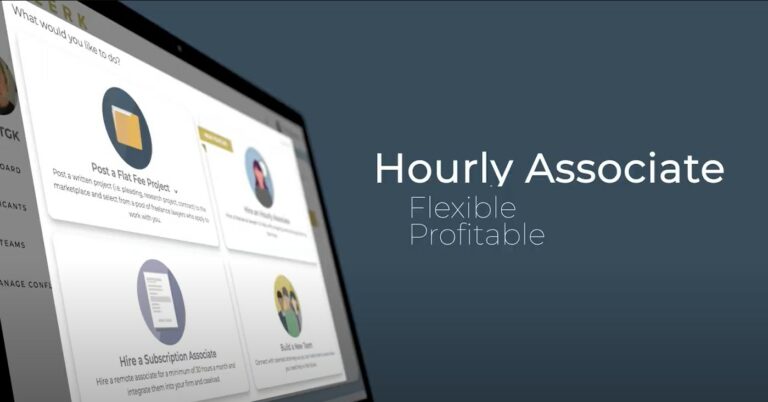For most of my 25+ year career in the legal profession, I have lived at the intersection of the “practice of law” and the “business of law”. I am among those of us who consider ourselves equal parts lawyer and businessperson. I cut my teeth in the business of law in my mid-30s when I became the managing partner of the regional firm I joined right out of law school. A very traditional law firm by all accounts.
In that position, I had to balance my growing practice and client base with managing our firm’s business and its long history, with a focus on its future. I liked to joke that I spent 75% of my time practicing law and 75% of my time managing the business of the firm.
From the late 1990s through the early 2010s, the business models of regional and national firms were similar; move up market with your new clients, try to be “full service”, and raise your billing rates 10% per year. And there is no doubt this model worked for many years. But it’s my experience that this unsustainable model began an inevitable downturn around 2005 (and wasn’t started by the Great Recession as many in the legal profession like to claim).
Let me pause here to note the obvious exception to my observation – the AmLaw 50. There are and have always been a number of the largest law firms who, in addition to being based in New York, tend to handle bet-the-company litigation or once in a generation M&A work. The stakes in this type of legal work are so high that hourly rates approaching $2,000 per hour are justified by the size and scope of the work. Their profits per partner continue to be at heights never previously seen and, from a financial perspective, have been pulling away from the pack. But they are the exception (i.e., the American Lawyer top 50), not the norm.
For the remainder of large firms (which I generally define as 35 lawyers or more), their businesses have been in a long-term state of deterioration. Clients have become much more rate sensitive, the ability to be everything to everybody is a promise that has proven hollow, and the pyramid model is unsustainable in a world where demand for legal services is not growing faster than the overall economy. And my regional firm was no different.
The firm I loved and had worked at so long (and helped to build) was broken. And it couldn’t be saved without a fundamental restructuring of the business model. None of my wonderful partners were at fault, it was simply the reality of a changing world and changing market dynamics.
Unfortunately, the flat firm management structure of most firms makes evolution very, very hard. The tough and structural changes needed were not appealing to too many of my partners. Thus, a relatively small group of us decided to start a boutique firm, where the business model was fundamentally different.
That decision has exceeded my most optimistic expectations. Our boutique firm doesn’t try to be everything to everybody. We focus on higher margins and lower overhead. We are relatively small, nimble and focused. We encourage working smarter not harder. We focus on creativity. We embrace success fees, alternative fees, flat fees, monthly retainers and remote associates. We stress deep client relationships. From our very first year, we have been more successful than any of us imagined when we designed our new business model. I, personally, have increased my income 3-5x more than I made in my best year at my old, much larger regional firm. Even with our smaller footprint, the quality of our client base has increased, and we have built a national reputation for the work we do and our work life balance has improved.
In this post, I’ll share my conclusion:
- Why the economies of larger law firms often aren’t sustainable in the long term; and
- How smaller law firms can avoid this trap and what a more sustainable, scalable business model looks like for them.
Toward the end of the article, I’ll also explain why, out of our own experience, we created a platform, to help small and midsize law firms operate more profitably and with less overhead by using incredibly experienced remote associates and freelance lawyers across the country (you can skip to this part of the story here).
How and When I Realized the Large Law Firm Business Model Was Broken
At my regional firm, we had added a number of high profile practice areas and some really great lawyers (including rainmakers). We had an intellectual property group that represented a who’s who in the areas of professional sports and entertainment. We had a premier criminal group that was the go-to defense team for elected officials and high profile criminal defendants. And you had my group of business, bankruptcy lawyers who regularly represented the largest companies across the country.
And upon this core foundation, we tried to be everything to everybody (that was our business model). Like most larger law firms, we had hired every type of lawyer you can imagine — employment lawyers, litigators, regulatory lawyers, criminal lawyers, bankruptcy lawyers, securities lawyers, mergers & acquisition, gaming lawyers, lobbyists and other professional non-lawyers, and so on.
You needed it, we had it.
We had been growing fast and allocating a fair amount of our profits to growth (i.e., new partner and associate salaries, office space, and support staff). But at the end of my sixth year as managing partner, we were concluding our fiscal year with revenue a couple of points down. Given the investments we were making to grow, it would impact partner distributions.
In mid-December, my CFO and I sat down in a conference room to analyze the year-end, and put together our strategic plan moving forward. We expected the process to take a couple of days as it had done in years past. But we ended up spending two weeks in that conference room examining fundamental changes to the business of law that had been quietly and invisibly shifting under our feet.
During those couple of weeks, we set out to explore and answer three questions:
- What changes need to be made to our business model?
- What does the future of midsize regional firms look like?
- What does the legal industry look like in 5-10 years?
At the end of that process, there was an obvious conclusion. The firm would need to make fundamental changes. And those changes would primarily be driven by altering the cost structure.
Three Fundamental Problems with the Cost Structure of Larger Law Firms
The cost structure of a law firm is driven almost exclusively by compensation to your lawyers, rent, the size (and cost) of your non-income generating staff, insurance and technology. Of course, you have to pay utilities, fill the conference rooms with refreshments, and buy office supplies, but those expenses are de-minimis in the context of overall operations.
Cost Structure Problem 1: Not All Practice Groups Share the Same Overhead; Profitable Practice Groups Subsidize Unprofitable Groups
At all law firms, compensating the lawyers and staff is the largest expense. Inside this expense category (compensation) is where we found our first critical insight: High margin practices were subsidizing lower margin practices (and offices).
This economic reality is extremely common in mid to large firms. The obvious example is that billing rates are not uniform across the legal spectrum. However, there are more hidden distinctions that are equally important. Some need extra staff who are an overhead cost instead of a revenue generator. Some need more infrastructure in the way of fancy conference rooms, paralegals, and marketing materials to win the proverbial “beauty contest”. Some simply have lower realization on their billings that sap profits. And obviously, some just have higher rates.
For instance, tax and securities lawyers are a great luxury for regional law firms attracting M&A work. However, in talking to my colleagues across the country, tax lawyers at all but the largest and most elite firms are more often a net cost than a profit center. But tax work often is justified as providing “intangible” benefit to the overall firm and being “necessary” to attract the work and clients the firm is aspiring to bring through the door. And that’s where the slippery slope begins.
Mid to large size firms strive to be “full service” and have all types of lawyers ready to jump on any conceivable client problem. However, that means the concept of shared overhead supported by practice groups with divergent economics is rampant: truth be told, there are lots of non-profitable practice groups adding to the cost structure of these firms.
Why do law firms continue to do this? Because there is a culture of trying to be everything to every client.
There is a notion in law firms that if we don’t have a particular practice group, we are at a strategic disadvantage. We may lose business if we can’t meet all of the client’s needs, because the client will go find a single firm that can. This idea is sound in principle, but uncommon in practice. It’s also aspirational on the part of firms and individual lawyers. There is no shortage of ego in our business and we want to perceive ourselves as being the best at everything we touch.
In my experience, and the experience of most other attorneys I’ve spoken to, cross-selling is rare for individual lawyers who work at large law firms. The idea that because you do a client’s corporate work you’re also going to capture litigation work is often a myth. Rather, large clients usually have their preferred firms for each individual practice group. In my experience, the go-to litigation firm is rarely the same as the go-to M&A firm for any given client.
Thus, based upon the limited success of most firms in cross-selling, it doesn’t make sense from a profitability standpoint to keep adding practice groups simply to be “full service”. Most often, this strategy simply drives up expenses without generating additional profit for firm partners.
Problem 2: Underutilized And Unprofitable Associates
The second cost structure problem at most midsize to large firms is simple: excess capacity. Capacity to take on that “next big case” is a luxury firms can’t build into their cost structure. With the cost of young associates in larger markets now exceeding $150,000 or more, and all the data showing the productivity and realization of “of-counsel” declining, firms can no longer justify the financial burden of underutilized lawyers. Associates are traditionally a fixed cost. Traditionally 1/3 of their billable revenue goes to compensation, 1/3 goes to overhead, and the LAST 1/3 goes to firm profit. But when associates are underutilized, it has a disproportionate impact on profit (as the other two categories are fixed). To put it bluntly, underutilized associates in a traditional salary model consume firm profits to the detriment of the firm’s partners.
Problem 3: Reverse Economies of Scale
Finally, there aren’t economies of scale in law firms. In fact, the economics of scale are inverted: The more attorneys you add to a law firm, the higher the cost structure. Once you go above a certain number of lawyers, you have to add layers of non-billable staff including management, marketing, legal assistants, finance and other employees. In addition, other overhead grows. The conference table gets longer. The billing department gets bigger. The video conference system gets more expensive. The client dinners get fancier. The computer systems get more complicated. Rent is higher. The list goes on.
So, for these three primary reasons, after my CFO and I spent 2 weeks in that conference room, it became apparent that the cost structure of many larger firms (like ours) was headed in the wrong direction. It was also apparent that the legal industry’s historical strategy of 10% annual rate increases was unsustainable.
It is entirely possible (if not likely) that we could have righted the ship for our firm in the short term, or more likely hidden and ignored the problem by increasing annual hourly requirements, but it had become clear that our profession was already in the midst of fundamental change and the law firm of the future needed to look very different.
How We Started a Boutique Law Firm to Create a More Sustainable, Scalable Business Model (Without Cost Structure Problems)
Background Story
The hard work surrounding the first few days of our new firm are some of my favorite memories. It definitely wasn’t as glamorous as being the managing partner at a large firm, but much more rewarding. We were our own IT department. I remember distributing computer equipment (still in boxes) on the first day and saying to our awesome staff that “we will figure out the rest.”
Over the weekend before we opened, one of my partners and I went to a big box electronics store and bought computers, monitors and equipment for the entire (but now much smaller) firm. We drove them all to the office and set them on the conference room table. That first morning, we rolled out the cloud based software we were going to use (having rejected servers that require an IT staff) and told everyone to “pick a computer, an office or a workspace and let’s get to work”. We were off to the races and have never looked back.
Our mentality was that of a startup. Let’s break the old ways and build it from scratch. Our motto was “never ask what the old firm would have done, what’s the best way”. It wasn’t perfect on day one, but I’m proud to say that we were cash flow positive in 40 days, and profitability has exceeded the most optimistic models we built before we launched.
Logistics: Exactly How Our Small Law Firm Business Model Avoids the Cost Structure Problems of Larger Firms
We decided to create a business model in which the two largest drivers of revenue would be business litigation and bankruptcy/restructuring. In our experience, these practice areas go hand in hand. These practices are designed and usually account for 80%+ of our annual revenue. We are intentionally not diversified in our revenue streams. But we also have real estate, finance, transactional and estate planning lawyers that have both stand-alone practices and support the restructuring and litigation work. In my opinion, diversification doesn’t lower your risk profile, it lowers your profit potential.
The goal isn’t to try to be everything to every client, because as we’ve discussed, the cost structure doesn’t make sense. We pursue high margin practices to the exclusion of low margin practices. And this avoids the pitfalls that accompany subsidization.
So now, at our smaller firm, if a client has an employment problem, we’re not going to solve it for them. We’re going to refer it to someone else who specializes in employment law. Someone we have built a relationship with and know will take care of our clients, and not steal them. And, by referring work to other boutique specialists, we have found that they refer their clients to us for the same reason. We provide excellent service in our niche areas, but never try to “steal the client”.
Second, at our firm, we solve the associate underutilization and overhead problems we discussed earlier by having fewer associates than our peak workload. In other words, we have enough work so that all our lawyers are at near 100% utilization all of the time. No one is subsidized and we don’t have idle capacity or underutilized associates.
While there are several benefits to the business model we built, running a small law firm also presents a unique set of challenges (which we set out to solve).
Why We Created a Marketplace for Remote Associates and Freelance Lawyers to Help Our Firm (and Other Small Law Firms) Scale More Effectively and Be More Profitable
There are two questions/concerns that arose when we first started our boutique firm:
- How do we support our existing client base and caseload with subject matter experts without growing to be the large firm we had just left?
- How do we service client needs at those times when we are at more than 100% capacity without permanently increasing headcount and overhead?
Like many law firms, we have experimented with contract lawyers, but with marginal success. We were always limited by the inability to find a deep pool of candidates and the process seemed slow and cumbersome.
And that’s when we decided to build it ourselves. Remote lawyers had long worked remote. The world had become comfortable with the gig economy and the business of law had proven it to be a better economic model. We decided we could solve the problem of finding subject matter experts and make hiring fast.
Building our own marketplace would solve our two big business concerns:
- Supporting our existing client base and caseload with the best lawyers who are subject matter experts – without growing to be the large firm we had just left.
- Service client needs at those times when our core team of lawyers is at 100% capacity without permanently increasing headcount and overhead.
The final question seemed to be: since we are lawyers, could we assemble the team to build the platform and could we attract the best and brightest lawyers, with every imaginable skillset, to work as remote associates and freelance lawyers?
The answer, it turned out, was a resounding yes!
Law Firms Are Uniquely Positioned to Work with Remote Associates (Virtual Associates) and Freelance Lawyers
The remote associates who join our marketplace, who now number in the thousands, are not freelancers because they “couldn’t get a real job”, which is a very common misconception.
Huge numbers of lawyers choose to work remotely or as freelance lawyers because they’ve worked at a big law firm for 10+ years and want to spend more time with their kids or take care of aging parents. And in a post-pandemic world, things are just different than they were a couple years ago. Remote work or freelancing is now the way most lawyers want to work. Our talent pool has thousands of lawyers who don’t want to go back to the office, are military spouses that are constantly relocated, law school professors and semi-retired lawyers who want to keep a foot in the business and love the intellectual challenge. Our biggest fear was finding top quality talent and it turned out that this is where the talented lawyers have been hiding for years.
Many lawyers on our marketplace have worked at the biggest and most successful firms in the world. They’ve been trained and practiced at the cutting edge of law. But then they leave “big-law.” Some don’t have the million-dollar book of business necessary to make partner. Some decide they want a better quality of life. And many have decided they prefer remote work and are not interested in returning to a full time office and billable hour requirements.
Burnout in this industry is real, and our marketplace permits some of the best and brightest lawyers to work on their own terms — when and how they want. It surprised me (although it shouldn’t have) that many lawyers just don’t want to deal with clients directly. They’re not interested in working in or running a firm. They just want to put their skill and knowledge to work “doing” the written work.
The lawyers on our marketplace average 11 years of experience, and they intentionally choose an alternative to the traditional legal career.
How Using Part-Time Remote Associates Freelance Lawyers Helps Our Firm Operate More Profitably
My firm, and thousands of other firms nationwide, use LAWCLERK to hire part time associates (subscription associates) and freelance lawyers to get work done without growing our headcount, even though we have plenty of work and could justify full-time hires. We do this because it’s a better solution for both our clients and our business. We find the best talent, are able to lower our cost structure, and are able to deliver a better product to our clients at a lower price. And even though we can lower the cost of legal services to our clients, our profits actually increase.
In a recent quarter, our firm spent $100,000 hiring subscription part-time associates (we have three in different practice areas) and freelance lawyers who help us on one off project work through LAWCLERK. They produced $275,000 of billable (and collected) time because it is ethically permissible in all 50 states to bill your freelancer’s time at reasonable market rates.
Over the last many months, several virtual associates with appellate and litigation expertise have worked with us as an extension of our own firm. We have eight bankruptcy lawyers in my practice group, and we often have enough work for around ten or more. So, we built a team of virtual associates that we found through the LAWCLERK marketplace, and we go to those same people over and over again.
Our firm is at nearly 100% capacity all times. That’s our business model. So, we use freelancers/virtual associates for that next 20% or 30% that we invariably have when the caseload picks up.
Among our team of virtual associates is a law school professor. He has practiced before the United States Supreme Court and clerked with a federal circuit court. We also have a subscription associate we use 60 hours a month who is a retired bankruptcy practitioner who frequently argued before dozens of bankruptcy courts, circuit courts, and the United States Supreme Court. We round out our team with several brilliant former big-law attorneys that have made the choice to go remote so that they can spend more time with their families. And when we have niche projects, discovery, or large document review projects, we go out to the marketplace and find the freelance attorneys with the ideal skill set.
LAWCLERK is a resource of remote and freelance lawyers who have incredibly specialized and great credentials. It helps us to run a more efficient and profitable firm without adding fixed costs. It allowed us to build a firm for the future.
I like the phrase “and being a good steward of”, but It was just too many words. I had to re-read it multiple times.
LAWCLERK Resources
We built LAWCLERK out of our desire, as practicing lawyers, to improve the work product we generate for our clients and the value we provide them. Yet at the same time we knew a better better business model existed than the one we had at a larger firm
If you’re curious and want to learn more, check out our Ultimate Guide to Legal Outsourcing or book a demo here to see how LAWCLERK can improve your practice and your firm.
In addition, we have an entire resources page with several useful documents, sample projects by area of law, podcast, webinar and tutorials, and more.
Finally, our YouTube channel is full of educational videos that help law firms and attorneys improve their profitability and general well-being.
Greg Garman is a founding partner at Garman Turner Gordon LLP, a boutique flaw firm with a national reputation in the area of corporate debtor representations in Chapter 11 bankruptcy proceedings. Greg is also a co-founder at LAWCLERK which provides virtual associates and freelance lawyers to growing firms focused on increasing their profits.
This post was originally published in August 2021 and updated in June 2021.
Jess Birken, Owner of Birken Law Office
“So I first heard of LAWCLERK and thought it was a brilliant idea. And I had desperately needed to delegate for a really long time. For whatever reason, I think lawyers are prone to that sort of ‘No, I have to do it myself’. And I’m as progressive as they come as far as doing this stuff.
And I still really just mentally resisted delegating. But my practice got to a point where with the subscription services, I wanted to offer so much more than I was capable of.
Even when I first started my account, I am embarrassed to admit that it took me several weeks — maybe even a month — to post my first project. And I don’t know what that was about.
Finally, my wingwoman Megan set me down on a table and said, ‘You’re not leaving this table until you post your first
project’.
And I literally called Ricky at LAWCLERK (each hiring attorney gets a dedicator advisor) … and he walked me through the process. I think I was really just not comfortable with a lot of unknowns, and so Ricky was delightful and got me through that first one.
And once I realized how easy it was, then I was off to the races…”
Ayesha Mehdi, Principal Attorney at Frontier Health Law
“I reached that stage in my practice very quickly when I needed help. But I didn’t want to take on the overhead that comes with hiring help and the expenses that come with it. I thought OK, I need to go on to LAWCLERK
finally.
The good thing about LAWCLERK is that it allows you to make teams, so I work with people in my team. Now I have enough of a relationship that I just contact them first and then ask them how much time they think that it’s going to take. They tell me and then I just post that price point for them.
They’re happy. I’m happy. And then the client is happy because things are getting done quicker and the product is better…”
Michael Cristalli, Partner in the law firm of Gentile Cristalli Miller Armeni Savarese
“When I was first introduced to LAWCLERK, I was skeptical. I didn’t understand the system and I didn’t know how it would benefit my law firm. I thought it would be easier to use my associates that I have in house with my law firm or do the work myself.
But when I understood the process and the simplicity associated with it, and then started interacting with the lawyers — and understood the level of experience they had and could deliver/bring to the table — it became a simple decision. And now I use it regularly and it has really changed the dynamics of my law practice.
What we have found is that LAWCLERK provides us a vehicle to get the best possible support for a particular case to get a specialty that will work best for us for the issue that our client is dealing with.
It does it in a way that’s economically not only reasonable, but economically beneficial to my law firm.
And also economically beneficial to the client. So we could service a client and give that client a specialty in a particular area of law that supports us in a case for a fraction of the cost.”






